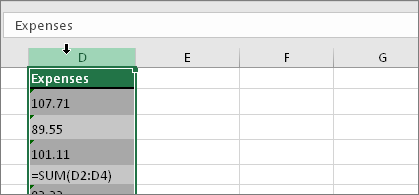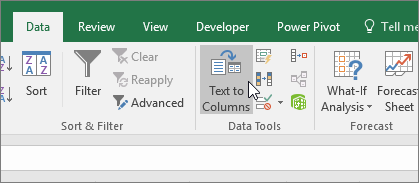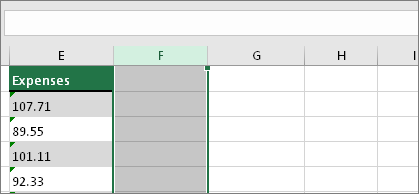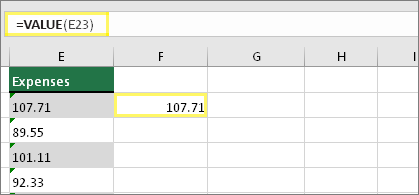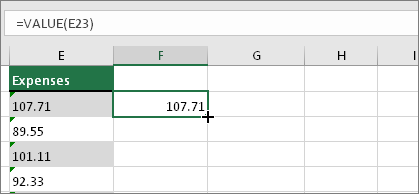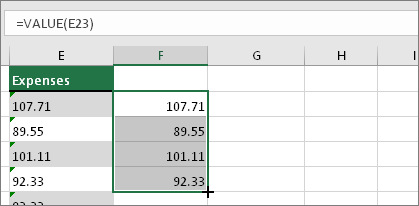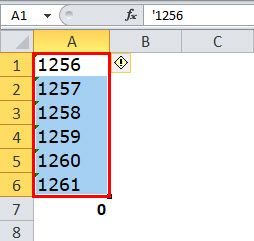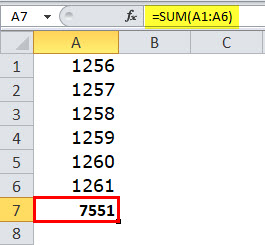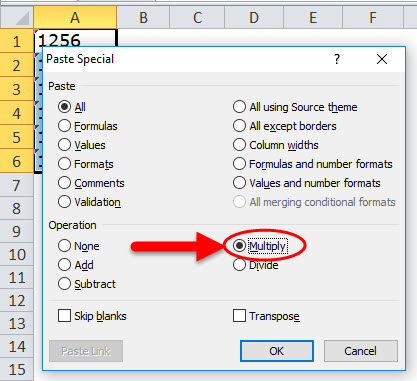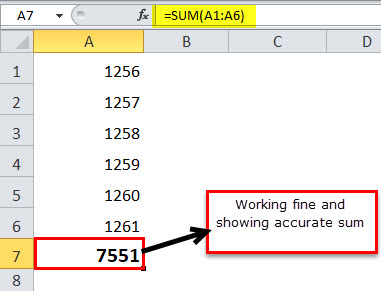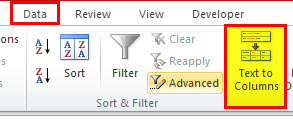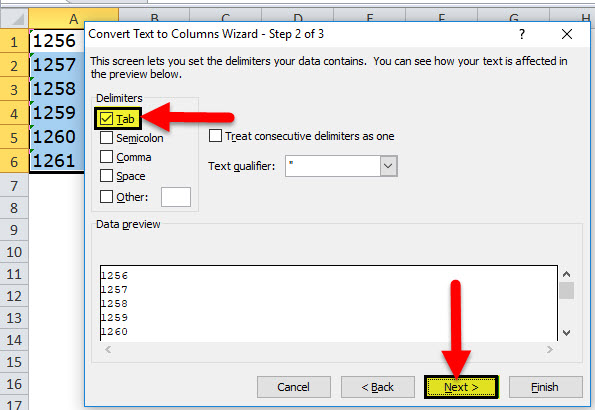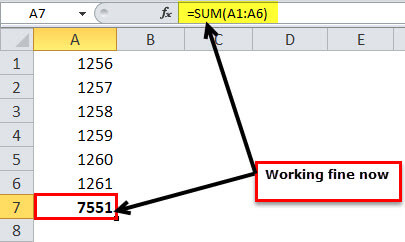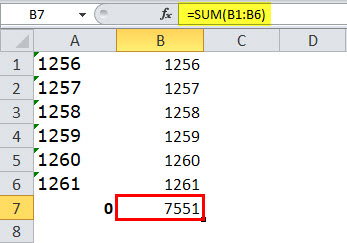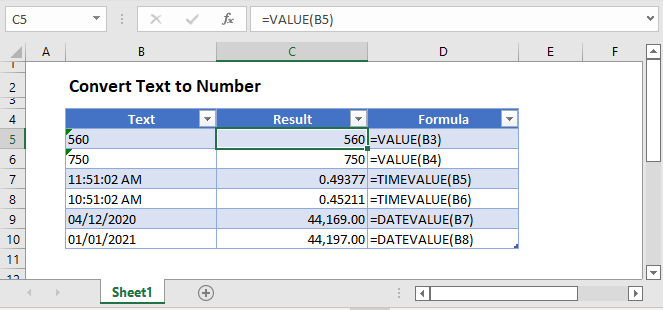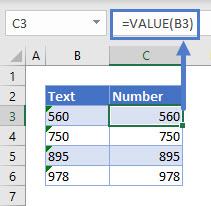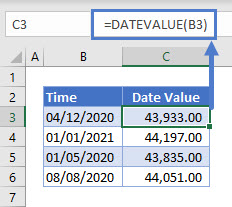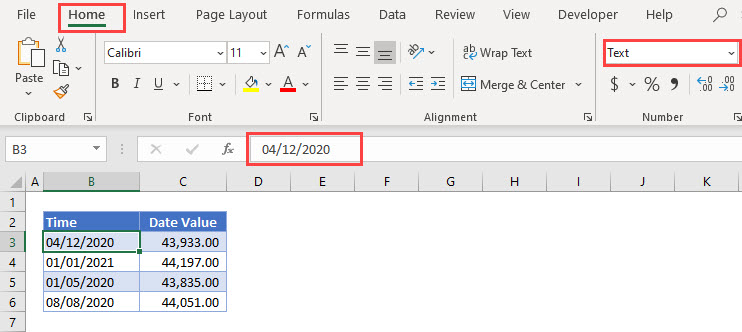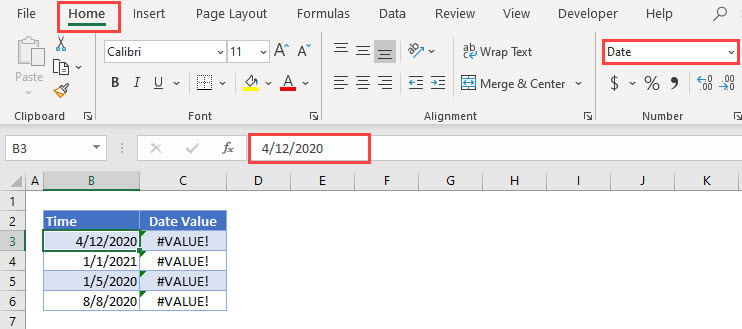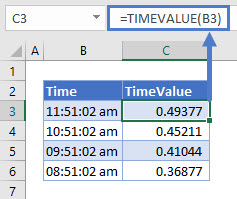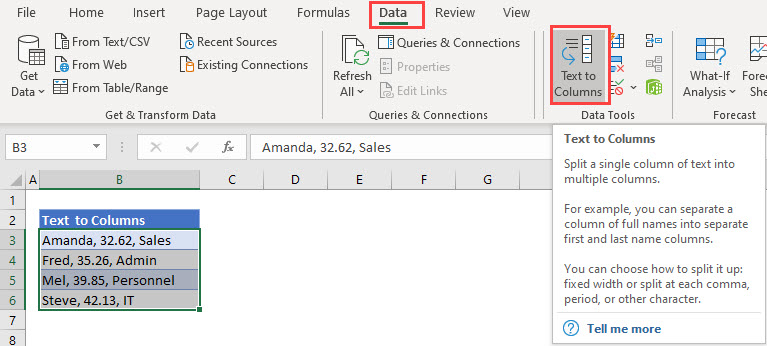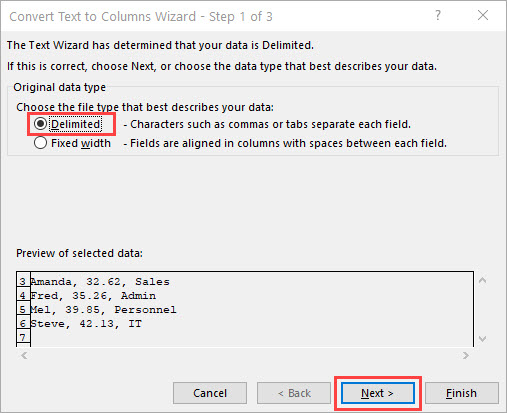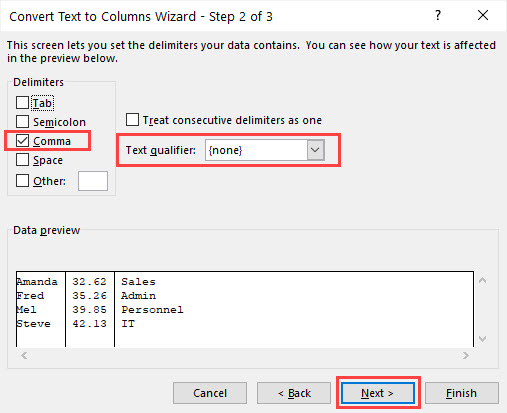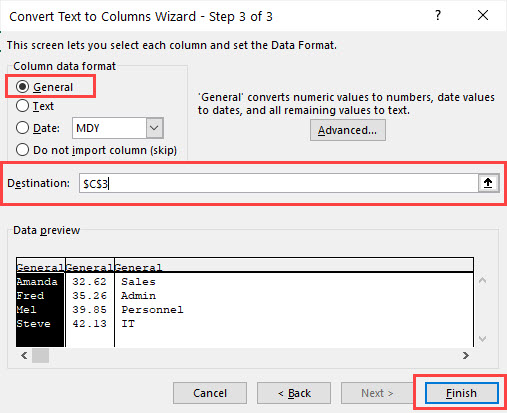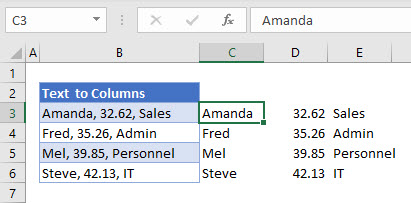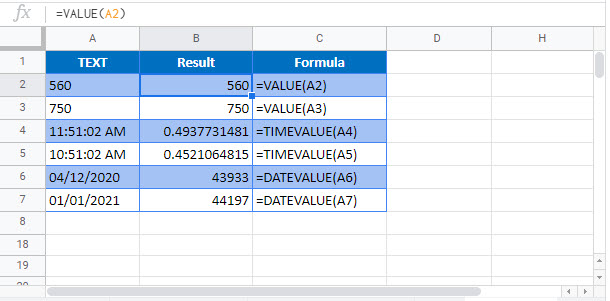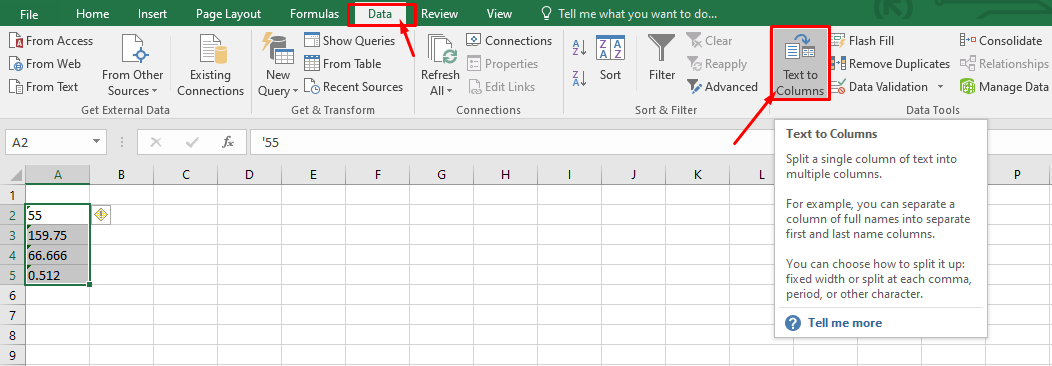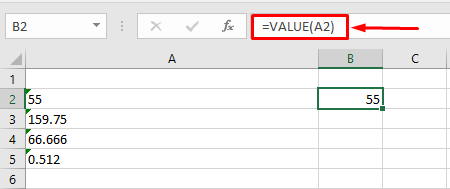Convert numbers stored as text to numbers
Excel for Microsoft 365 Excel for Microsoft 365 for Mac Excel 2021 Excel 2021 for Mac Excel 2019 Excel 2019 for Mac Excel 2016 Excel 2016 for Mac Excel 2013 Excel Web App Excel 2010 Excel 2007 Excel for Mac 2011 Excel Starter 2010 More…Less
Numbers that are stored as text can cause unexpected results, like an uncalculated formula showing instead of a result. Most of the time, Excel will recognize this and you’ll see an alert next to the cell where numbers are being stored as text. If you see the alert, select the cells, and then click 
Check out Format numbers to learn more about formatting numbers and text in Excel.

If the alert button is not available, do the following:
1. Select a column
Select a column with this problem. If you don’t want to convert the whole column, you can select one or more cells instead. Just be sure the cells you select are in the same column, otherwise this process won’t work. (See «Other ways to convert» below if you have this problem in more than one column.)
2. Click this button
The Text to Columns button is typically used for splitting a column, but it can also be used to convert a single column of text to numbers. On the Data tab, click Text to Columns.
3. Click Apply
The rest of the Text to Columns wizard steps are best for splitting a column. Since you’re just converting text in a column, you can click Finish right away, and Excel will convert the cells.
4. Set the format
Press CTRL + 1 (or 
Note: If you still see formulas that are not showing as numeric results, then you may have Show Formulas turned on. Go to the Formulas tab and make sure Show Formulas is turned off.
Other ways to convert:
You can use the VALUE function to return just the numeric value of the text.
1. Insert a new column
Insert a new column next to the cells with text. In this example, column E contains the text stored as numbers. Column F is the new column.
2. Use the VALUE function
In one of the cells of the new column, type =VALUE() and inside the parentheses, type a cell reference that contains text stored as numbers. In this example it’s cell E23.
3. Rest your cursor here
Now you’ll fill the cell’s formula down, into the other cells. If you’ve never done this before, here’s how to do it: Rest your cursor on the lower-right corner of the cell until it changes to a plus sign.
4. Click and drag down
Click and drag down to fill the formula to the other cells. After that’s done, you can use this new column, or you can copy and paste these new values to the original column. Here’s how to do that: Select the cells with the new formula. Press CTRL + C. Click the first cell of the original column. Then on the Home tab, click the arrow below Paste, and then click Paste Special > Values.
If the steps above didn’t work, you can use this method, which can be used if you’re trying to convert more than one column of text.
-
Select a blank cell that doesn’t have this problem, type the number 1 into it, and then press Enter.
-
Press CTRL + C to copy the cell.
-
Select the cells that have numbers stored as text.
-
On the Home tab, click Paste > Paste Special.
-
Click Multiply, and then click OK. Excel multiplies each cell by 1, and in doing so, converts the text to numbers.
-
Press CTRL + 1 (or
+ 1 on the Mac). Then select any format.
Related topics
Replace a formula with its result
Top ten ways to clean your data
CLEAN function
Need more help?
Want more options?
Explore subscription benefits, browse training courses, learn how to secure your device, and more.
Communities help you ask and answer questions, give feedback, and hear from experts with rich knowledge.
It’s common to find numbers stored as text in Excel. This leads to incorrect calculations when you use these cells in Excel functions such as SUM and AVERAGE (as these functions ignore cells that have text values in it). In such cases, you need to convert cells that contain numbers as text back to numbers.
Now before we move forward, let’s first look at a few reasons why you may end up with a workbook that has numbers stored as text.
- Using ‘ (apostrophe) before a number.
- A lot of people enter apostrophe before a number to make it text. Sometimes, it’s also the case when you download data from a database. While this makes the numbers show up without the apostrophe, it impacts the cell by forcing it to treat the numbers as text.
- Getting numbers as a result of a formula (such as LEFT, RIGHT, or MID)
- If you extract the numerical part of a text string (or even a part of a number) using the TEXT functions, the result is a number in the text format.
Now, let’s see how to tackle such cases.
Convert Text to Numbers in Excel
In this tutorial, you’ll learn how to convert text to numbers in Excel.
The method you need to use depends on how the number has been converted into text. Here are the ones that are covered in this tutorial.
- Using the ‘Convert to Number’ option.
- Change the format from Text to General/Number.
- Using Paste Special.
- Using Text to Columns.
- Using a Combination of VALUE, TRIM, and CLEAN function.
Convert Text to Numbers Using ‘Convert to Number’ Option
When an apostrophe is added to a number, it changes the number format to text format. In such cases, you’ll notice that there is a green triangle at the top left part of the cell.
In this case, you can easily convert numbers to text by following these steps:
- Select all the cells that you want to convert from text to numbers.
- Click on the yellow diamond shape icon that appears at the top right. From the menu that appears, select ‘Convert to Number’ option.
This would instantly convert all the numbers stored as text back to numbers. You would notice that the numbers get aligned to the right after the conversion (while these were aligned to the left when stored as text).
Convert Text to Numbers by Changing Cell Format
When the numbers are formatted as text, you can easily convert it back to numbers by changing the format of the cells.
Here are the steps:
- Select all the cells that you want to convert from text to numbers.
- Go to Home –> Number. In the Number Format drop-down, select General.
This would instantly change the format of the selected cells to General and the numbers would get aligned to the right. If you want, you can select any of the other formats (such as Number, Currency, Accounting) which will also lead to the value in cells being considered as numbers.
Also read: How to Convert Serial Numbers to Dates in Excel
Convert Text to Numbers Using Paste Special Option
To convert text to numbers using Paste Special option:
Convert Text to Numbers Using Text to Column
This method is suitable in cases where you have the data in a single column.
Here are the steps:
- Select all the cells that you want to convert from text to numbers.
- Go to Data –> Data Tools –> Text to Columns.
- In the Text to Column Wizard:
While you may still find the resulting cells to be in the text format, and the numbers still aligned to the left, now it would work in functions such as SUM and AVERAGE.
Convert Text to Numbers Using the VALUE Function
You can use a combination of VALUE, TRIM and CLEAN function to convert text to numbers.
- VALUE function converts any text that represents a number back to a number.
- TRIM function removes any leading or trailing spaces.
- CLEAN function removes extra spaces and non-printing characters that might sneak in if you import the data or download from a database.
Suppose you want convert cell A1 from text to numbers, here is the formula:
=VALUE(TRIM(CLEAN(A1)))
If you want to apply this to other cells as well, you can copy and use the formula.
Finally, you can convert the formula to value using paste special.
You May Also Like the Following Excel Tutorials:
- Multiply in Excel Using Paste Special.
- How to Convert Text to Date in Excel (8 Easy Ways)
- How to Convert Numbers to Text in Excel
- Convert Formula to Values Using Paste Special.
- Excel Custom Number Formatting.
- Convert Time to Decimal Number in Excel
- Change Negative Number to Positive in Excel
- How to Capitalize First Letter of a Text String in Excel
- Convert Scientific Notation to Number or Text in Excel
- How To Convert Date To Serial Number In Excel?
This post is going to show you all the ways you can convert text to numbers in Microsoft Excel.
An issue that comes up quite often in Excel is numbers that have been entered or formatted as text values.
This can cause many headaches when trying to troubleshoot why a formula like a SUM is not giving the correct answer.
Even though the data looks like a number, it can actually be a text value and will be ignored from any numerical calculations like a sum.
In this post, I will show you how you can identify such numbers which are stored as text values, and 7 ways you can use to convert the text into a proper number value.
How to Indentify Numbers Entered as Text
How can you tell if your number data has been entered as text?
There are quite a few easy ways to tell!
Left Aligned
The first way you might be able to tell if you have text values instead of numerical values is the way the data is aligned in the cell.
By default text is left aligned and numbers are right aligned.
Unless the alignment formatting has been changed from the default, this will be an easy way to spot numbers that have been formatted as text.
Green Triangle Error Checking
If you don’t realize you have numbers entered as text values, it can potentially cause some serious errors. This is why it’s flagged by Excel’s built-in error checker.
Any cells that are flagged with an error will show a small green triangle in the left of the cell to visually indicate an error.
When you select such a cell a small warning icon will appear.
When you click on this, it will show you what the error is. In this case, you can see the error is Number Stored as Text.
You can turn off this error checking entirely, or customize which errors are flagged.
Go to the File tab and then select Options at the bottom. This will open up the Excel Options menu.
In the Formula section of the Excel Options menu ➜ Error Checking.
Uncheck the Enable background error checking option to disable this feature. You can also customize the color used to indicate errors here.
Text Format Applied
One way that numbers get entered as text is when the cell has been formatted as text. This causes values to be entered as text values regardless of whether they are numerical.
There is a quick way to determine whether or not a cell has had text formatting applied.
Select the cell and go to the Home tab. You will be able to see if Text is the selected formatting in the dropdown menu found in the Number section of the ribbon.
Preceding Apostrophe
Another way that numbers can be entered as text is by using a preceding apostrophe.
When you enter an apostrophe ' as the first character in a cell, anything after will be regarded as a text value by Excel.
This means if you see a leading apostrophe in the formula bar, you know the data is a text value.
Use the ISTEXT Function
Excel has a function you can use to test if a value is a text value or not.
ISTEXT ( input )- input is the value, cell or range which you want to test if it is text.
The ISTEXT function will return TRUE if the value is text and FALSE otherwise.
= ISTEXT ( B3 )Here you can see the ISTEXT function being used to determine if the cells contain text. The function returns TRUE when it finds a text value.
ISNUMBER ( input )- input is the value, cell or range which you want to test if it is a number.
Similarly, you can test if a value is a number using the ISNUMBER function. It takes a single input and returns TRUE when the value is a number and FALSE otherwise.
Here the same data is tested using the ISNUMBER function. The function returns FALSE when it does not find a number.
Status Bar Only Shows a Count
Another way to quickly test a range of cells to see if they are all text is by using the status bar.
When you select a range of numerical values, Excel will show you some basic statistics like the sum, min, max, and average in the status bar.
If they are all numbers entered as text values, then these basic statistics won’t be calculated. Instead, you will only see the count of the cells in the status bar.
Note: If just one of the cells is a numerical value, you will see the full set of statistics in the status bar.
Convert Text to Number with Error Checking
You have already seen that you can use error checking to spot numbers entered as text.
The error checking will also allow you to convert these text values into proper numbers.
Click on the Error icon and choose Convert to Number from the options. Excel will then convert each cell in the selected range into a number.
Note: This option can be very slow when you have a large number of cells to convert.
Convert Text to Number with Text to Column
Usually, Text to Columns is for splitting data into multiple columns. But with this trick, you can use it to convert text format into the general format.
Text to Column will let you choose a delimiter character to split your data based on. If you deselect this option and don’t pick any delimiter then it won’t split your data.
You are then able to choose how to format the results, and this is where you can choose a general format for the output.
Follow these steps to use the text to column feature to convert text to numbers.
- Select the cells that contain the text which you want to convert into number.
- Go to the Data tab.
- Click on the Text to Column command found in the Data Tools tab.
- Select Delimited in the Original data type options.
- Press the Next button.
- Press the Next button again in step 2 of the Convert Text to Columns wizard. You can keep the default options.
- Select General from the Column data format option.
- Select a Destination if you want to place the converted values in a new location. Otherwise you can keep the default value which should be the active cell, this will replace the text with numeric values.
- Press the Finish button.
This will convert your text values into numerical values.
The Text to Column command is usually used to split comma-separated or other delimiter separated data into multiple columns.
Any delimited data will be text data, so when Excel splits the data into multiple columns it also converts numerical data into numbers for added convenience.
This is also true even if there is nothing to split!
So the Text to Column wizard can be used to converts numerical text values to numbers.
Convert Text to Number with Multiply by 1
Even when values are stored as text you can still perform certain numerical calculations with them and the results of these calculations will also be numerical values.
You can use this to convert the text into numbers by multiplying them by 1. Since you are multiplying by 1, it won’t change the numbers but it will convert them.
= B3 * 1You can use the above formula in an adjacent cell and copy and paste it down to convert an entire column.
If you want to remove the formula after, you can copy and paste them as values.
Convert Text to Number with Paste Special Multiply
Multiplying by 1 is a great trick for converting text to values, but you might not want to use a formula for this.
The great news is there is an easy way to multiply your text by 1 without using a formula.
This means you can convert your text in place and you don’t need to copy and paste formulas as values in an additional step.
You can use Paste Special Multiply to convert your text values. Follow these steps to multiply by 1 using Paste Special.
- Enter 1 into a cell elsewhere in the sheet. The 1 doesn’t even need to be a number value and can be a text value.
- Copy the cell which contains 1 using Ctrl + C on your keyboard or right click and choose Copy.
- Select the cells with the text values to convert.
- Press Ctrl + Alt + V on your keyboard or right click and choose Paste Special. This will open up the Paste Special menu.
- Select Values under the Paste options and select Multiply under the Operation options.
- Press the OK button.
This will multiply all the values by 1 which was the value in the copied cell. As a result, the text is converted into values, but since you are multiplying by 1 the numbers won’t change.
Convert Text to Number with VALUE Function
There is actually a dedicated function you can use for converting text to numerical values.
The VALUE function takes a text value and returns the text value as a number.
= VALUE ( text )- text is the text value you want to convert into a numerical value.
If the text contains any non-numerical characters, then the VALUE function will return a #VALUE! error. It doesn’t extract numbers from text, it can only convert numbers entered as text into numbers.
= VALUE ( B3 )You can use the above formula to convert the text in cell B3 into a number and then copy and paste the formula to convert the entire column.
Convert Text to Number with Power Query
Power Query is an amazing tool for any type of data transformation required. It can certainly be used to convert text into numbers as well.
Power Query is strongly typed. This means calculations with incompatible data types will result in an error. So you won’t be able to multiply text values by 1 to convert them into numbers.
But Power Query does come with an easy way to convert data types, including text to numbers.
Follow these steps once your data has been imported into Power Query.
Click on the data type icon to the left side of the column heading for the values you want to convert.
Each column in the Power Query editor has a data type icon that displays the current data type of the column. If the column has not been assigned a data type, then the icon shown will be ABC123.
There are several numeric data types available in Power Query and which one you choose will depend on the level of decimal precision you need.
In this case, you can select the Whole Number option from the menu.
Notice the values in the column are now right-aligned and the data type icon has changed? These are visual indicators that the data type is now whole numbers instead of text.
= Table.TransformColumnTypes(Source,{{"Text", Int64.Type}})You will see a new Changed Type step has been applied to the query and it will use the above M code formula.
You can then press the Close & Load button in the Home tab to save the results and load the data into Excel.
You might not even need to apply this data type conversion step to your query. When you first import data into Power Query, it will usually guess the data type and apply the conversion for you!
Convert Text to Number with Power Pivot
If you want to analyze or summarize your data after you convert it from text to numbers, then you might want to do the conversion in Power Pivot.
Power Pivot is an add-in that allows you to efficiently analyze millions of rows in the data model with Pivot Tables.
With Power Pivot, you can build row-level calculations using the DAX formula language to create new columns in your datasets. You can then access these new columns in your pivot tables connected to the data model.
In this case, the DAX formula you can use to convert text to numbers is the exact same as the formula in the grid.
Follow these steps inside the Power Pivot add-in to create a new calculated column that converts the text to numbers.
Select any cell under the Add Column heading.
=VALUE(TextNumbers[Text])Insert the above formula. TextNumbers is the name of the table of data in Power Pivot and Text is the name of the column you want to convert.
Double click on the column heading to change the name.
Press the Save icon and close the Power Pivot add-in.
Now you can create a pivot table from the data model and this new column will be available for use inside the pivot table just like any other field.
- Go to the Insert tab.
- Click on the PivotTable button.
- Choose From Data Model in the available options.
The calculated column will be available in your pivot table fields list and you will be able to use it like any other number field.
Conclusions
There are many reasons why you might have data that contains numbers formatted as text.
If you want to freely use these values in your calculations, you will need to convert them into numbers.
Thankfully, there are many easy options to convert text to numbers such as error checking, paste special, basic multiplication, and the VALUE function. These are all easy ways to convert text inside the grid.
If you’re importing your data using Power Query or Power Pivot, you can perform the conversion inside each of these tools. Both have methods available to convert text to numbers.
Do you use any of these methods to change your text values to numbers? Do you know any other interesting ways to perform this action? Let me know in the comments below!
About the Author
John is a Microsoft MVP and qualified actuary with over 15 years of experience. He has worked in a variety of industries, including insurance, ad tech, and most recently Power Platform consulting. He is a keen problem solver and has a passion for using technology to make businesses more efficient.
How to Convert Text to Numbers in Excel? (Step by Step)
There are many ways we can convert text to numbers in Excel. We will see them one by one.
- Using quick convert text to numbers Excel option.
- Use a special cell formatting method.
- Using the Text to ColumnText to columns in excel is used to separate text in different columns based on some delimited or fixed width. This is done either by using a delimiter such as a comma, space or hyphen, or using fixed defined width to separate a text in the adjacent columns.read more Method.
- Using the VALUE function.
Table of contents
- How to Convert Text to Numbers in Excel? (Step by Step)
- #1 Using quick Convert Text to Numbers Excel Option
- #2 Using Paste Special Cell Formatting Method
- #3 Using the Text to Column Method
- #4 Using the VALUE Function
- Things to Remember
- Recommended Articles
You can download this Convert Text to Numbers Excel Template here – Convert Text to Numbers Excel Template
#1 Using quick Convert Text to Numbers Excel Option
It is probably the simplest of ways in Excel. Many people use the apostrophe ( ‘ ) before entering the numbers in Excel.
Below are the steps for converting text to numbers Excel option:
- We must first select the data.
- Then, we need to click on the error handle box and select the “Convert to Number” option.
- That would instantly convert the text-formatted numbers to number format, and now the SUM function works well and shows the accurate result.
#2 Using Paste Special Cell Formatting Method
Now let us move to another way of changing the text to numbers. Here we are using the Paste Special methodPaste special in Excel allows you to paste partial aspects of the data copied. There are several ways to paste special in Excel, including right-clicking on the target cell and selecting paste special, or using a shortcut such as CTRL+ALT+V or ALT+E+S.read more. Again, consider the same data we used in the previous example.
- Step 1: First, we must type the number either zero or 1 in any one cell.
- Step 2: Now, we need to copy that number. (We have entered the number 1 in cell C2).
- Step 3: Now, we must select the numbers list.
- Step 4: Now, we must press ALT + E + S (Excel shortcut keyAn Excel shortcut is a technique of performing a manual task in a quicker way.read more for the pastespecial method). That will open up the below dialog box. Select the multiply option. (We can try to divide also).
- Step 5: As a result, it would instantly convert the text to numbers, and the SUM formula is working well now.
#3 Using the Text to Column Method
It is the third method of converting text to numbers. It is a bit lengthier process than the earlier two, but it is always good to have as many alternatives as possible.
- Step 1: We must first select the data
- Step 2: We need to click on the “Data” tab and the “Text to Columns” option.
- Step 3: As a result, it will open up the below dialog box and ensure “Delimited” is selected. Click on the “Next button.”
- Step 4: We must ensure the “Tab” box is checked and click on the “Next” button.
- Step 5: In the next window, we must select the “General” option, select the destination cell, and click on the “Finish” button.
- Step 6: Consequently, this would convert text to numbers, and SUM may work now.
#4 Using the VALUE Function
In addition, a formula can convert text to numbers in Excel. The VALUE function can perform the job for us. We must follow the below steps to learn how to do it.
- Step 1: First, we must apply the VALUE formula in cell B1.
- Step 2: We need to drag and drop the formula into the remaining cells.
- Step 3: Then, apply the SUM formula in cell B6 to check whether it has converted or not.
Things to Remember
- If we find the green triangle button in the cell, there must be something wrong with the data.
- The VALUE function can be useful in converting the text string that represents a number to a number.
- If spacing problems exist, we nest the VALUE function with the TRIM function. For example, =Trim(Value(A1))
- The “Text to Column” can also correct dates, numbers, and time formats.
Recommended Articles
This article is a guide to Convert Text to Numbers in Excel. Here, we discuss how to convert text to numbers in Excel using 1) Error handler, 2) text to the column, 2) PasteSpecial, and 4) Value Function and Excel examples and downloadable Excel templates. You may also look at these useful functions in Excel: –
- Convert Columns to Rows in Excel
- Convert Date to Text
- Convert Numbers to Text in Excel
- Convert Excel to CSV
Return to Excel Formulas List
Download Example Workbook
Download the example workbook
This tutorial will demonstrate how to convert text to numbers in Excel and Google Sheets.
VALUE Function
If you have a number stored as text in Excel, you can convert it to a value by using the VALUE Function.
=VALUE(B3)DATEVALUE Function
If you have a date stored as text in Excel, you can get the date value from it by using the DATEVALUE Function.
=DATEVALUE(B3)This will only work, however, if the date is stored as text.
If the date is stored as an actual date, the DATEVALUE Function will return an error.
TIMEVALUE Function
If you have time stored as text, you can use the TIMEVALUE Function to return the time value. The TIMEVALUE function will convert the text to an Excel serial number from 0 which is 12:00:00 AM to 0.999988426 which is 11:59.59 PM.
=TIMEVALUE(B3)TEXT to COLUMNS
Excel has the ability to convert data stored in a text string into separate columns, using Text to Columns. If there are values within this data, it will convert the value to a number.
- Select the range to apply the formatting (ex. B3:B6)
- In the Ribbon, select Data > Text to Columns.
- Keep the option as Delimited, and click Next
- Select Comma as the Delimiter, and make sure that the Text qualifier is set to {none}.
- Select cell C3 as the destination for the data. You do not need to change the Column data format as Excel will find the best match for the data.
- Click Finish to view the data. If you click in cell D3, you will see that the number part of the text string has been converted to a number.
Convert Text to Number in Google Sheets
All of the examples above work the same way in google sheets.
It is quite a frustrating situation when the numbers are formatted or stored as text in an Excel spreadsheet. Due to this, you’ll be unable to perform various Excel tasks like creating charts from values, mathematical calculations, or grouping them into arrays. But don’t worry, in this write-up, you’ll learn how to convert text to number in Excel using 6 different ways.
So, without any further ado, let’s get started…
Follow the below step-by-step methods for converting text to numerical values in MS Excel.
- Use the ‘Convert to Number’ Option
- Use Paste Special with Multiply
- Use the ‘Text to Columns’
- How to Convert the Text to Number with the VALUE Function
- Excel Convert Text To Number Using VBA
- Changing Cell Format
Way 1: Use the ‘Convert to Number’ Option to Convert Text to Number Excel
The very first way that you can try to convert text to number using the option ‘Convert to Number’. This option will eventually help you to convert the data that is been entered in the Excel with an apostrophe.
Here is how you can use this option:
- Initially, select the Excel cells that you need to convert to the number format.
- Then, you’ll see one yellow diamond exclamation symbol near the selection.
- Simply, click on a dropdown >> select the option ‘Convert to Number’.
- Now, you will be getting your text converted to the number.
Way 2: Use Paste Special with Multiply
In Microsoft Excel, Paste Special is a fabulous tool that also helps to convert text to numbers in Excel.
So, here we will use the Paste Special feature to convert the text into numbers and to perform the simple calculation.
Here is how you can do so:
- Enter the value 1, in any blank cell.
- After that select, the particular cell where you type 1 > on the Edit menu. Click Copy.
- And with the values select the cells that you need to convert to numbers.
- Next on Edit menu >> click Paste Special.
- Then under Paste Special operation >> select All >> click Multiply >> OK.
Note: If you are getting any issues while pasting your data in the Excel worksheet, check out this post.
Way 3: Use the ‘Text to Columns’
This method works best if data is arranged in a single column. The example presumes that the data is in column A and starts in row 1 ($A$1).
Follow the steps to do so:
- Choose one column of cells that holds the text.
- And on the Data menu > click Text to Columns.
- After that under Original data type > click Delimited > click Next.
- Next under Delimiters > click to choose the Tab check box > click Next.
- And under Column data format > click General.
- Then click Advanced > make any appropriate settings for the Decimal separator > Thousands separator and click OK.
- Click Finish.
And that all your text is converted to numbers.
Way 4: How to Convert Text to Number in Excel with the VALUE Function
The VALUE function is a handy way that can be used for converting the text to numbers.
Here you have to type the below command in the cell:
= VALUE (text)
- Here, text is the value that you need to convert to a numerical value.
In case, if your text contains non-numerical characters, the VALUE function returns a #VALUE! error. And it doesn’t give you the result that you want.
= VALUE (B3)
Now, the above formula can be used to convert text in the Excel cell B3 to a numerical value and then copy & paste a formula in order to convert the complete column.
Way 5: Excel Convert Text To Number Using VBA
Another very interesting way to make your Convert Text to Numerical values is by using the VBA code. It is well applicable to Excel 2003/2007 application version.
It is found that in many cases all the above-mentioned solution fails to work. Well in a such situation, using VBA works great.
The following VBA Macro code is provided on the Microsoft page to make Excel convert Text to Number.
Sub Enter_Values()
For Each xCell In Selection
xCell.Value = xCell.Value
Next xCell
End Sub
If in case the above VBA code shows an error on execution, then you need to do the following changes in coding:
For Each xCell In Selection
xCell.Value = CDec(xCell.Value)
Next xCell
Way 6: Changing Cell Format
Changing the cell format is another yet way that can assist you to convert text to number Excel successfully.
- For this, you have to right-click on the cell(s).
- Click on “Format Cells.”
- After this, choose “Number” tab >> click on “Number” on a left.
- Now, you can adjust the Decimal Places >> click “OK.”
Related FAQs:
What Is the Shortcut to Convert to Number in Excel?
The Ctrl + Alt + V is the shortcut to convert to numbers. All you need to do is to select the cells that you need to convert to numbers, then press the Ctrl + Alt + V keys simultaneously.
How Do I Convert Text to Number in Excel VLOOKUP?
By using the Value Function, you can convert the text to number in Excel VLOOKUP.
How Do I Convert Text to Number in Excel Cell?
You can convert text to number in Excel cell using the Paste Special feature, error checking, or Value Function.
Also Read: How to Convert Access To Excel File? [The Definitive Guide]
To Sum Up
Well, this is all about how to convert text to number in Excel in easy ways. I tried my level best to put together the possible steps that will help you out.
All you need to do is to follow the given steps one by one and convert text to number in MS Excel effortlessly.
Thanks for reading this post!
Priyanka is an entrepreneur & content marketing expert. She writes tech blogs and has expertise in MS Office, Excel, and other tech subjects. Her distinctive art of presenting tech information in the easy-to-understand language is very impressive. When not writing, she loves unplanned travels.
A common frustration in Excel is when numbers are stored as text.
You will not be able to perform Excel tasks such as mathematical calculations, create charts from the values, or group them into ranges while the numbers are stored as text.
In this tutorial, you will learn how to recognize numbers stored as text and multiple ways to convert text to numbers.
Here’s what we’ll cover:
- How to check if a value is numeric or text
- The ‘Convert to Number’ Excel option
- Change text to numbers with Paste Special
- Using Text to Columns to convert text
- Convert text to numbers using formulas
You can follow along with this workbook.
1. How to check if a value is numeric or text
It is not always clear that a number is stored incorrectly. It can appear as a number, yet be stored as text. This causes much confusion for Excel users.
However, there are some things to look out for, and ways to accurately check it.
Firstly, Excel will always display text to the left of a cell and numeric values to the right of a cell. So, if a value is left-aligned, it is probably text.
This is just a clue and not guaranteed, because users can change the alignment of cell values. However, it is a great place to start and a good clue to look out for.
Another way of checking is to select the range of values and look at the calculations down on the Status Bar.
If the values are all numeric, you will probably see average, count and sum calculations. And if any are text, only the count is performed.
Once again, these calculations can be changed by users so it’s not a perfect check. However, it will work 95% of the time and is a fast and easy way of checking.
To be completely sure, we can use an Excel function named ISNUMBER. This function will return TRUE if the value is numeric and FALSE if it is not.
You only need to provide the ISNUMBER function with the value to check. In this example, the following formula was entered into cell C2.
=ISNUMBER(B2)
I have converted some of the values to numbers. So, even though they all look like numbers, the ISNUMBER formula returns FALSE, making it easy to identify the problem values.
2. The ‘Convert to Number’ Excel option
The first technique we will look at to convert text to numbers is the ‘Convert to Number’ option provided in Excel.
It is quick and simple, but it is unfortunately not always available to you.
This option is available when numbers are stored as text as a result of downloading the data from a website or some database, or maybe copied and pasted between programs.
Also, it may be that someone accidentally typed an apostrophe before the number. This tells Excel to store the number as text, and is very useful for entering ‘fake’ numbers such as phone numbers and ID numbers.
A green triangle is shown in the top left corner of the cell if this option is available to you.
This triangle means that the value has failed one of Excel’s error check rules, and is used to identify other errors outside of just recognizing numbers stored as text.
To convert to numbers;
- Select the range of cells to change.
- Click the exclamation mark icon and click Convert to Number.
The values are converted. The green triangle has disappeared and the values are now right aligned. This is how we expect to see numbers.
3. Change text to numbers with Paste Special
Paste Special in Excel is a fabulous tool. It is no surprise that it can help us convert text to numbers too.
To do so, we need to use Paste Special to perform a simple calculation. When a text value is used in a calculation, the result is numeric.
- Type the number 1 in a cell, any cell.
- Copy that cell value.
- Select the range of values you need to convert to numbers.
- Click Home > Paste list arrow and Paste Special.
5. Select Values and the Multiply operation. Click Ok.
4. Using Text to Columns to convert text
Text to columns is another great way to quickly convert text to numbers.
- Select the range of values.
- Click Data > Text to Columns.
- Step 1 of the Text to Columns wizard regards splitting text between columns. We do not need this, so click Next.
4. In step 2 remove all delimiter checkboxes.
5. Step 3 asks about the value formatting. Leave it as General (the date option is great when working with date values). Click Finish.
You probably didn’t change an option during the Text to Columns process, and we could have clicked Finish before step 3.
However, you may have to consider if your value contains delimiters such as spaces or commas.
I like this method of converting text to numbers. It is quick and simple.
5. Convert text to numbers using formulas
The previous methods are great, but they require manual intervention. A user will need to perform the steps to convert the text to numbers.
With a formula, we can automate the solution. It will not change the value in the cell containing text, but rather, create a clean version in another cell.
If the data is regularly changed, a formula will ensure that the values fed to a PivotTable, chart or other formulas continue to be numeric. And no manual intervention is required.
Using a formula is also great for combining with other functions. For example, converting results from text functions into numbers.
That is the example we will look at here.
In this example, we have data downloaded from a source and the values in column B are stored as text due to the dollar sign.
Using a formula, the number has been extracted successfully. However, the RIGHT and LEN functions used in the formula are text functions. So, the result is returned as text.
The VALUE function of Excel converts text that represents a number to a number.
Using this function, the result of the RIGHT function is converted from text to number.
The values can then be formatted as required. For example, in the accounting format with the dollar sign.
Final thoughts and further reading
So there you have it: some simple methods for converting text to numbers. If you’re getting to grips with Excel in your quest to become a data analyst, you can try a free data analytics short course here. Keen to learn more Excel functions? Check out the following:
- How to use the XLOOKUP function in Excel
- How to use the COUNTIFS function in Excel
- How to use the IFERROR function in Excel
- How to insert the Delta symbol in Excel

